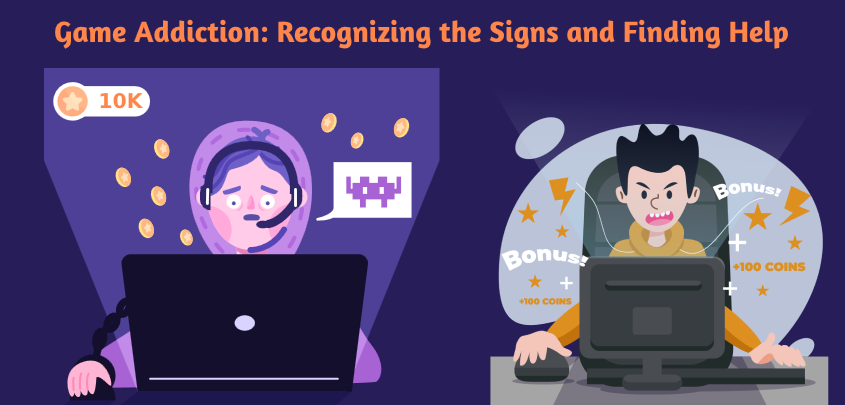
19, Sep, 2024
Game Addiction: Recognizing the Signs and Finding Help
Gaming addiction isn’t just about playing too much; it’s about how deeply it can affect various aspects of life. While some signs are well-known, others go unnoticed. Here are some lesser-known psychological, behavioural, and physiological signs of gaming addiction and tips for managing them.
Psychological Signs
1. Mood Swings and Temperament Issues
- What to Look For: Increased irritability, anger, or frustration, especially when not gaming or after in-game losses. This can manifest as difficulty controlling emotions, leading to outbursts.
- What You Can Do: Practise mindfulness techniques like deep breathing or meditation. Set breaks during gaming sessions to manage emotions.
2. Escapism and Avoidance
- What to Look For: Using games as an emotional escape to avoid stress, personal problems, or anxiety. The virtual world becomes a refuge from real-life challenges.
- What You Can Do: Acknowledge the underlying issues and seek healthier coping mechanisms, such as talking to a counsellor or engaging in relaxing offline activities like journaling or yoga.
3. Anxiety and Depression
- What to Look For: Experiencing anxiety or depressive symptoms, such as feeling hopeless, worthless, or disconnected from reality when away from games.
- What You Can Do: Therapy (such as Cognitive Behavioral Therapy) can help address these emotional imbalances and improve mental well-being.
4. Cognitive Decline
- What to Look For: Struggling with memory, concentration, or problem-solving in non-gaming contexts can be a sign. Some gamers find it hard to switch from the fast-paced nature of games to more complex real-world thinking.
- What You Can Do: Brain exercises like puzzles, strategy board games, or reading can help retrain your mind to think critically and avoid cognitive atrophy.
5. Emotional Blunting
- What to Look For: Gaming can create an emotional buffer, leading to emotional numbness in real-life situations. Over time, players may become desensitised to stress, joy, or sadness in non-gaming scenarios.
- What You Can Do: Mindfulness and emotional recognition exercises (e.g., meditation) can help reconnect with your real-life emotions, making them easier to manage.
Behavioural Signs
1. Neglecting Personal Hygiene
- What to Look For: Skipping basic self-care routines like showering, brushing teeth, or changing clothes due to extended gaming sessions.
- What You Can Do: Establish personal hygiene checklists, set alarms for breaks, and pair self-care tasks with gaming rewards to promote balance.
2. Isolation and Strained Relationships
- What to Look For: Distancing oneself from family, friends, or partners in favour of gaming. Games take priority over real-life interactions, leading to strained relationships.
- What You Can Do: Set boundaries for gaming time and schedule regular social activities offline to maintain healthy relationships.
3. Impulsiveness and Poor Decision-Making
- What to Look For: Engaging in risky or impulsive behaviour, such as spending excessive amounts of money on in-game purchases or ignoring responsibilities (work, school) to play.
- What You Can Do: Use apps that help limit spending or time spent on games. Keeping track of finances and game-related expenses can promote better control.
Physiological Signs
1. Sleep Deprivation
- What to Look For: Staying up late or pulling all-nighters to play games, leading to chronic sleep deprivation. This negatively impacts cognitive functions and emotional well-being.
- What You Can Do: Create a bedtime routine and set a gaming curfew. Use blue-light filters on screens to reduce the impact of gaming on your sleep cycle.
2. Physical Health Decline
- What to Look For: Weight fluctuations due to a sedentary lifestyle or skipping meals while gaming. Gamers might also experience constant fatigue or body aches from lack of physical activity.
- What You Can Do: Set hourly reminders to stand, stretch, and take short walks. Play games that incorporate movement, such as VR or fitness-oriented games.
- What to Look For: Experiencing frequent eye strain, blurred vision, or headaches due to prolonged screen time.
- What You Can Do: Follow the 20-20-20 rule: every 20 minutes, look at something 20 feet away for at least 20 seconds. This helps reduce strain on the eyes.
Seeking Help for Gaming Addiction
If you recognize these signs, it’s important to take action before gaming negatively impacts your well-being. Here’s how you can start:
1. Cognitive Behavioral Therapy (CBT)
- CBT helps individuals recognize and change unhealthy gaming patterns by addressing the underlying emotional and psychological triggers.
2. Digital Detox Programs
- These programs offer structured breaks from technology, helping individuals reconnect with life outside gaming and establish healthy boundaries.
3. Peer Accountability Groups
- Joining a support group or community where people share experiences with gaming addiction can provide motivation and accountability for positive changes.
By identifying and addressing psychological, behavioural, and physiological signs of gaming addiction, players can maintain a healthy balance between enjoying games and protecting their overall well-being.
